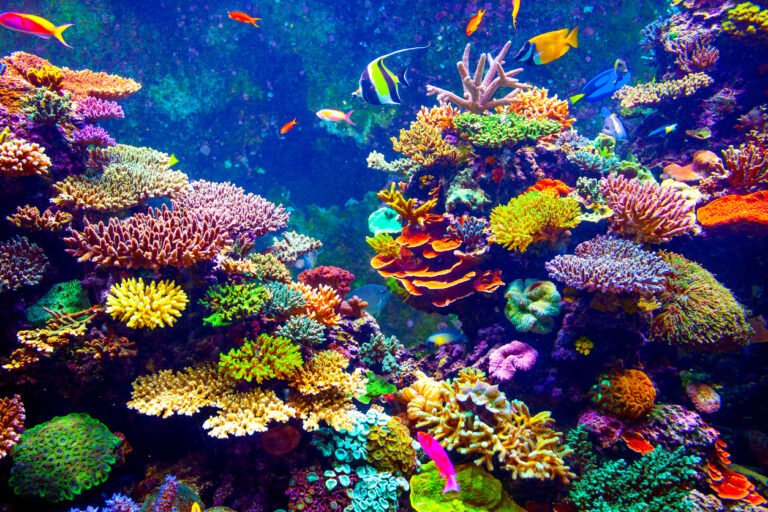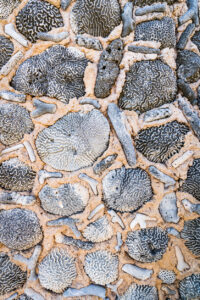Table of Contents
Coral, with its organic origins and rich history, is a unique and captivating element of the marine world. Unlike typical minerals, coral is formed by living organisms, creating an intricate and vibrant underwater landscape. This natural wonder comes in a kaleidoscope of colors, from soft pinks to deep reds, symbolizing life’s vitality and an enduring connection to the sea.
Formation
Coral formation is a complex and beautiful natural process primarily driven by tiny marine animals called coral polyps, which are related to jellyfish and sea anemones. These polyps engage in a symbiotic relationship with microscopic algae known as zooxanthellae. Living within the coral polyps’ tissues, the zooxanthellae perform photosynthesis, thereby providing nutrients and oxygen to the coral. In return, the coral offers a safe environment and the necessary compounds for photosynthesis. The polyps secrete a hard exoskeleton of calcium carbonate, which gradually accumulates and forms the coral reefs over time. These reefs, rich in biodiversity, are vital marine ecosystems and serve as natural barriers protecting coastal regions. The balance and health of coral reefs, however, are sensitive to environmental changes, highlighting their ecological importance.
Coral is not a crystal, it is classified as a natural organic gemstone rather than a mineral or crystal.
Color
Coral comes in a wide range of colors influenced by factors like species, symbiotic algae, and environmental conditions. The most classic and sought-after is red coral, but it can also be found in various colors such as pink, orange, yellow brown and white. Blue, green and black corals considred less common. Some corals even display multicolor combinations, blending various hues together.
Origins
Coral is found in various countries around the world, primarily in coastal regions with warm waters. These countries include Australia, Indonesia, the Philippines, Maldives, Egypt, Fiji, Belize, Hawaii, and various nations in the Caribbean. Each of these coastal regions is known for its unique coral ecosystems and contributes to the global richness of coral diversity, making them popular destinations for marine enthusiasts and nature lovers.
History
The history of coral is intertwined with human civilization, spanning cultures and centuries. Our knowledge of coral’s use in ancient civilizations is derived from archaeological discoveries, historical records, and ancient artifacts. Archaeologists have unearthed coral artifacts in ancient burial sites, tombs, and archaeological excavations, including coral jewelry, amulets, and decorative items, providing tangible evidence of its use. Some ancient texts and writings from civilizations such as Egypt, Greece, and Rome make references to coral or materials believed to be coral, offering historical documentation of its use in rituals, adornment, and symbolism. Ancient artworks, including paintings, sculptures, and carvings, often depict individuals wearing jewelry or ornaments made of coral, providing visual insights into its use in ancient societies. Records from various periods in history mention the use of coral, its symbolism, and its cultural significance, including accounts, letters, and diaries from people of those times.
In recent times, there has been a growing awareness of coral conservation due to the vulnerability of coral reefs to environmental changes and human activities. Efforts to protect and preserve these crucial marine ecosystems are underway.

Many coral reefs around the world are threatened by overharvesting and habitat destruction, and some coral species are protected by international regulations to prevent their depletion. As a result, there has been a shift towards using alternatives like synthetic or imitation coral, as well as sustainably sourced coral, to create jewelry while minimizing the impact on coral reefs. Buyers and jewelry makers should be aware of the source and legality of the coral used in their products to ensure responsible and ethical practices.
Spiritual Aspects
- Chakra Alignment: Coral is associated with the root chakra, helping to ground and stabilize one’s energy, promoting a sense of security and connection to the Earth.
- Spiritual Growth: It is believed to facilitate spiritual growth and awakening, encouraging individuals to explore their spiritual path and higher consciousness.
- Protection: Coral is often believed to provide protection against negative energies and psychic attacks, it is often carried by sailors and travelers as a protective talisman against sea-related dangers and accidents.
- Connection to the Sea: It is associated with the ocean and is believed to enhance one’s connection to water elements and the energies of the sea.
- Enhanced Intuition: Some believe that wearing or meditating with coral can sharpen one’s intuition and psychic abilities.
Emotional Aspects
- Emotional Stability: Coral is said to help individuals achieve emotional stability and inner peace, reducing anxiety and stress.
- Communication: It is believed to improve communication skills and foster a sense of harmony in relationships.
- Concentration: Coral may enhance mental focus and concentration, making it useful for studying or work-related tasks.
- Self-Confidence: Wearing coral is thought to boost self-confidence and self-esteem, aiding in self-expression and assertiveness.
- Releasing Negative Patterns: Some practitioners believe coral can help release old emotional patterns and traumas, facilitating personal growth.
Physical Aspects
- Blood Circulation: Coral is often associated with improving blood circulation, which can benefit those with circulation-related issues.
- Bone Health: It is believed to strengthen bones and promote healthy skeletal growth, making it useful for those with bone disorders.
- Digestive Aid: Coral is sometimes used to alleviate digestive problems and promote a healthy gut.
- Skin Conditions: In some traditional medicine systems, coral is applied topically to address skin conditions and wounds.
- Energy Boost: Coral may provide an energy boost, helping combat fatigue and increasing overall vitality.
Hard corals VS Soft corals
Corals can be broadly categorized into two main types: hard corals and soft corals. Hard corals have stony skeletons and form large colonies of polyps, relying on a symbiotic relationship with algae. They come in various shapes and colors, building coral reefs over time. Soft corals lack the rigid skeleton and have a more flexible structure made of protein, often displaying feathery or fan-like appearances with vibrant colors. They are carnivorous, capturing prey with their tentacles. Both types of corals play crucial roles in marine ecosystems, with hard corals building reefs and providing habitat, while soft corals contribute to the underwater biodiversity with their unique forms and colors.
Fossil coral
Fossil coral, also known as agatized or petrified coral, is a gemstone formed from ancient coral reefs through a process of mineralization over millions of years. It retains the original coral structure but is now composed of stone with colors ranging from brown to red and more. Fossil coral’s intricate patterns and warm hues make it a popular choice for jewelry and decorative items. It is believed to possess metaphysical properties related to grounding, emotional balance, and connection to ancient wisdom. Fossil coral formations offer insights into Earth’s history and the evolution of marine environments, making them valuable for scientific research.

